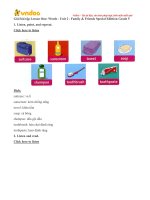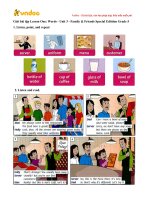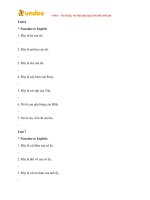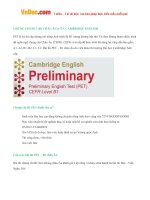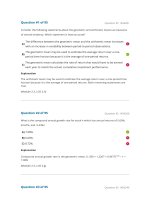cambridge IGCSE chemistry study and revision guide
Bạn đang xem bản rút gọn của tài liệu. Xem và tải ngay bản đầy đủ của tài liệu tại đây (6.64 MB, 342 trang )
Author’sdedication
ToMartha,SarahandJoseph.Thankyouforeverything.
HachetteUKspolicyistousepapersthatarenatural,renewableandrecyclable
productsandmadefromwoodgrowninsustainableforests.Theloggingand
manufacturingprocessesareexpectedtoconformtotheenvironmental
regulationsofthecountryoforigin.
Orders:pleasecontactBookpointLtd,130ParkDrive,MiltonPark,Abingdon,
OxonOX144SE.Telephone:(44)01235827720.Fax:(44)01235400454.
Email:Linesareopenfrom9a.m.to5p.m.,
MondaytoSaturday,witha24-hourmessageansweringservice.Youcanalso
orderthroughourwebsite:www.hoddereducation.com
ISBN9781471894602
eISBN9781471894626
đIGCSEistheregisteredtrademarkofCambridgeInternationalExaminations.
Thequestions,exampleanswers,marksawardedand/orcommentsthatappearin
thisbookwerewrittenbytheauthor.Inexamination,thewaymarkswouldbe
awardedtoanswerslikethesemaybedifferent.
ThisbookhasnotbeenthroughtheCambridgeendorsementprocess.
âDavidBesser2017
Firstpublishedin2017by
HodderEducation,
AnHachetteUKCompany
CarmeliteHouse
50VictoriaEmbankment
LondonEC4Y0DZ
www.hoddereducation.com
Impressionnumber10987654321
Year201920182017
Allrightsreserved.ApartfromanyusepermittedunderUKcopyrightlaw,no
partofthispublicationmaybereproducedortransmittedinanyformorbyany
means,electronicormechanical,includingphotocopyingandrecording,orheld
withinanyinformationstorageandretrievalsystem,withoutpermissionin
writingfromthepublisherorunderlicencefromtheCopyrightLicensing
AgencyLimited.Furtherdetailsofsuchlicences(forreprographicreproduction)
maybeobtainedfromtheCopyrightLicensingAgencyLimited,SaffronHouse,
610KirbyStreet,LondonEC1N8TS.
Coverphoto©fox17–Fotolia
IllustrationsbyIntegraSoftwareServicesPvt.LtdTypesetinITCGalliardStd
Roman11/13byIntegraSoftwareServicesPvt.Ltd.,Pondicherry,IndiaPrinted
inSpain
AcataloguerecordforthistitleisavailablefromtheBritishLibrary.
Contents
Introduction
1Theparticulatenatureofmatter
2Elements,compoundsandexperimentaltechniques
3Atomicstructure,bondingandstructureofsolids
4Stoichiometry:chemicalcalculations
5Electricityandchemistry
6Chemicalenergetics
7Chemicalreactions
8Acids,basesandsalts
9ThePeriodicTable
10Metals
11Airandwater
12Sulfur
13Inorganiccarbonchemistry
14Organicchemistry1
15Organicchemistry2
16Experimentalchemistry
Answerstoexam-stylequestions
Index
Introduction
WelcometotheCambridgeIGCSE®ChemistryStudyandRevisionGuide.This
bookhasbeenwrittentohelpyoureviseeverythingyouneedtoknowforyour
Chemistryexam.FollowingtheChemistrysyllabus,itcoversallthekeycontent
aswellassamplequestionsandanswers,practicequestionsandexaminertipsto
helpyoulearnhowtoanswerquestionsandtocheckyourunderstanding.
Howtousethisbook
Keyobjectives
Thekeyskillsandknowledgecoveredinthechapter.Youcanalsousethisasa
checklisttotrackyourprogress.
Keyterms
Definitionsofkeytermsyouneedtoknowfromthesyllabus.
Sampleexam-stylequestions
Exam-stylequestionsforyoutothinkabout.
Student’sanswers
Typicalstudentanswerstoseehowthequestionmighthavebeenanswered.
Examiner’scomments
Feedbackfromanexaminershowingwhatwasgood,andwhatcouldbe
improved.
Examiner’stips
Advicetohelpyougivetheperfectanswer.
Commonerrors
•Mistakesstudentsoftenmakeandhowtoavoidthem.
Extended
Contentfortheextendedsyllabusisshadedgreen.
Exam-stylequestions
Practicequestionsforyoutoanswersothatyoucanseewhatyouhavelearned.
Howtorevise
Thisbookisnotintendedtogivedetailedinformationaboutthechaptersyouare
requiredtostudyfortheIGCSEChemistrycourse.Insteaditismeanttogive
conciseinformationconcerningthethingsthatyouarelikelytocomeacrossin
yourexaminations.Youhaveprobablybeenusingamoredetailedtextbookover
thetwoyearsofyourcourse.Thisbookisintendedforuseoverthesixweeks
justbeforetheexaminations.
Notwopeoplereviseinthesameway.Itwouldbefoolishtogiveprecise
instructionstoanyoneabouthowtheyshouldprepareforexaminations.
However,Iintendtomakesomesuggestionsaboutthedifferentapproachesthat
areavailable,sothatyoucanchoosethemethodsthataremostsuitableforyou.
TheonlythingIwouldstronglyrecommendaboutrevisionisthatitshould
involvewritingaswellasreading.Thosewhoreadthroughnotesorbooksas
theironlymeansofrevisingoftenfindthattheybecomedistractedandstart
thinkingaboutotherthings.Writingthingsdownhelpsyoutofocusonwhatyou
aretryingtolearn.
Anotherwaytohelpyoulearnistohighlightkeywordsandphrasesthatyou
wishtodrawattentionto.Highlightingmakesyoufocusonthingsthatyoumay
havehadproblemswithuptonow.
Afterhighlighting,youcouldrewritethehighlightedparts,leavingouttheless
importantparts.Itmayalsobeagoodideatoleaveoutthosepartsthatyou
alreadyknow.Ifyouknowthattransitionelementsareallmetals,thereisno
pointinwritingitdown,becauseyoudonotneedtoreviseit.Justfocusonthe
partsthatyouarenotsofamiliarwith.Yournoteswillbemoreconciseandmore
personalthantheinformationinthebook.Youmayprefertowritedownthe
informationinamoreeye-catchingform,suchasinadiagram.Theimportant
thingisthatitispersonaltoyouandhelpsyourrevision.
Whenyouhavemadenotesofthistype,trywritingthemout.Againjustfocus
ontheimportantkeywordsandphrases.Whenyoucanwritethemoutwithout
lookingatyournotes,youmaybeconfidentthatyouhavelearnedthisparticular
chapter.Youcantestyourselfbyansweringthe‘Exam-stylequestions’sections
ofthebookaswellaslookingatpastpaperquestionsorquestionsyouhave
attemptedduringthecourse.Ifyoucomeacrossaproblem,alwaysgobackto
yournotesandothersourcesofinformation.Thereisnoneedtoattempttimed
questionsunderexamconditionsuntilmuchnearertheexam.
Examtechnique
Themostimportantpiecesofadvicethatanyonecangiveabouthowtoapproach
anexamarenotnew.However,itiswellworthrepeatingthem,becausethe
pointsmadebelowarestillmajorcausesofavoidablelossesofmarks.
•Writeclearly.Ifexaminerscannotreadwhatyouhavewritten,theycannot
awardmarks,despitetheirbesteffortstodecipheryourwork.Inthis
technologicalage,whenhandwritingisnotusedasmuchasitwasinthepast,
itisessentialthatyouranswerscanberead.
•Usecorrectspellings.TechnicaltermsusedinChemistrymustbewritten
correctly.Incorrectspellingsdomorethancreateabadimpressionofa
candidate’swork.Ifawordisincorrectlyspelt,itoftenchangesthewhole
meaningoftheword.Anexampleisusingtheword‘alkane’insteadof
‘alkene’.Thisisnotonlyaspellingmistake,butitreplacesonewordwithan
entirelydifferentwordwhichhasanentirelydifferentmeaning.
•Readthequestionscarefully.Donotjustglanceataquestionandpickouta
fewwords.Readthewholequestionandwhenyouhavereadit,readitagain.
Aquestionmaylooklikeanotheroneyouhaveseenduringyourrevision,but
ifyoureaditmorecarefully,youmayrealisethattherearedifferenceswhich
meanthatadifferentapproachisrequiredtoanswerthequestion.
•Checkyouranswers.Whenyouhavefinishedeachquestion,readthroughit
tomakesureitmakessenseandthatitanswersthequestion.
•Donotspendtoolongonanyquestions.Ifyouspendtoolongonsome
questions,youmayfindyoudonothavethenecessaryamountoftimeto
answersomeoftheothers.Itisimportanttoanswerallthequestions.
Somecommonphrasesthatyouwillseeinquestions,andtheirmeanings,
include:
•Definetheterm/whatismeantbythetermmeansgiveadefinitionofa
wordorphrasewhichonlyappliestothatwordorphrase.Forexample,
‘Definethetermisotope’meansgiveastatementthattellssomeoneexactly
whatanisotopeis.Definitionsarefoundinthe‘Keyterms’sectionatthestart
ofeachchapter.
•Statemeansgiveabriefstatement.Noexplanationofthestatementis
required.Forexample,‘Statethenameoftheacidthatisusedtomake
magnesiumsulfate’.
•Explain/giveareasonorreasons.Thissometimesfollowsthecommand
word‘state’,i.e.‘stateandexplain’or‘stateandgiveareason’.Thismeans
youshouldgiveapieceofinformationfollowedbyabriefexplanationofwhy
youchosethisinformation.
•Outlinemeansabriefdescriptionisrequired.
•Predictmeansyouaremeanttomakeaprediction,notbasedonany
knowledgethatyouhaveremembered,butbymakingalogicalconnection
betweenotherpiecesofinformationreferredtointhequestion.
•Deducealsomeansyouarenotrequiredtogiveananswerbasedonwhatyou
haveremembered,buttosuggestalogicalconnectionbasedoninformationin
thequestion.
•Suggestmaymeanthereismorethanonepossibleanswer.Itmayalsomean
youarerequiredtoapplyyourknowledgeofChemistrytoa‘novel’situation,
e.g.anexperimentorareactionyouhavenotcomeacrossbefore.Insuch
examples,youwillbesuppliedwithsufficientinformationtomakea
reasonablesuggestion.
•Calculate/determinemeanscarryoutacalculationbasedondatathatis
provided.
•Howwouldyou…?meansgiveabriefdescriptionofanexperimentthatyou
wouldcarryout.Manyexamcandidatesanswerthistypeofquestionwithtoo
muchtheoreticalinformationratherthanbriefexperimentaldetail.
1Theparticulatenatureofmatter
Keyobjectives
Bytheendofthissection,youshould
knowthedifferentpropertiesofsolids,liquidsandgases•beabletodescribe
thestructureofsolids,liquidsandgasesintermsofparticleseparation,
arrangementandtypesofmotion•knowwhatismeantbymelting,boiling,
evaporation,freezing,condensationandsublimation•beabletodescribethe
effectoftemperatureonthemotionofgasparticles•haveanunderstandingof
Brownianmotion•beabletodescribeandexplaindiffusion
•beabletoexplainchangesofstateintermsofthekinetictheory•beableto
describeandexplainBrownianmotionintermsofrandommolecular
bombardmentandstateevidenceforBrownianmotion•beabletodescribe
andexplaindependenceofrateofdiffusiononrelativemolecularmass.
Keyterms
Melting
Theprocessthatoccurswhenasolidturnsintoaliquid
Meltingpoint Thetemperatureatwhichasubstancemelts.Eachsubstancehasa
specificmeltingpoint
Boiling
Theprocessthatoccurswhenaliquidturnsintoagas
Boilingpoint Thetemperatureatwhichasubstanceboils.Eachsubstancehasa
specificboilingpoint
Evaporation Theprocessthatoccursatthesurfaceofaliquidasitturnsintoa
gas.Evaporationcanoccurattemperatureslowerthantheboiling
pointofaliquid
Freezing
Theprocessthatoccurswhenaliquidturnsintoasolid
Freezing
Thetemperatureatwhichasubstancefreezes.Thishasthesame
point
valueasthemeltingpoint
CondensationTheprocessthatoccurswhenagasturnsintoaliquid
Sublimation Theprocessthatoccurswhenasolidturnsintoagaswithoutfirst
turningintoaliquid
Brownian
Therandommotionofvisibleparticlescausedbybombardment
motion
bymuchsmallerparticles
Diffusion
Theprocessthatoccurswhenparticlesmovefromaregionof
highconcentrationtoaregionoflowconcentration
Solids,liquidsandgases
Differencesbetweensolids,liquidsandgasesareshowninFigure1.1.
Examiner’stip
Whenaskedtodrawdiagramsofthearrangementofparticlesinsolids,liquids
andgases,solidsandgasesareusuallydrawnquitewell,buttheparticlesin
liquidsareusuallydrawntoofarapart.Inreality,themajorityofparticlesina
liquidaretouching.
Thedifferencesbetweenthepropertiesofsolids,liquidsandgases,alongwith
thereasons(basedonkinetictheory)forthedifferences,areshowninTable1.1.
Changesofstate
Figure1.2summarisesthechangesinstatethatoccurbetweensolids,liquidsand
gases.
Commonerror
•Thereisoftenconfusionbetweenboilingandevaporation.Boilingonlytakes
placeattheboilingpointofaliquid,butevaporationoccursattemperatures
belowtheboilingpoint.Puddlesofwaterevaporateonasunnyday.This
meansthatthewaterturnsintowatervapourattemperatureswellbelowthe
boilingpointofwater.Thewaterinthepuddlesdoesnotreach100°C!
Heatingandcoolingcurves
Aheatingcurveshowsthechangesofstateoccurringwhenthetemperatureof
iceisgraduallyincreased.Asimilar(butnotthesame)curveresultswhenagas
iscooledgraduallyuntilitformsasolid.Thisisknownasacoolingcurve.
Theprocessbeginswithiceatatemperaturebelow0°C.Thetemperature
graduallyincreasesuntilitreaches0°C,whichisthemeltingpointofice.At
thispointiceandwaterexisttogether.Thetemperaturedoesnotchangeuntilall
theicehaschangedintowaterwhichiswhythelineishorizontal.Asharp
meltingpoint(atonespecifictemperature)isanindicationthatanysolidispure.
Thetemperaturethenbeginstoincreaseagainuntilitreaches100°Cwhichis
theboilingpointofwater.Thetemperaturedoesnotchangeuntilallthewater
haschangedintowatervapourwhichiswhythelineishorizontalforasecond
time.Whenallthewaterhasboiled,thetemperaturebeginstoriseagainasthe
particlesinthegaseousstategainmoreenergy.
KinetictheoryWhenheatenergyisgiventoasolid,
theheatenergycausestheparticlestovibratefaster
andfasteraboutafixedpositionuntiltheparticles
havesufficientenergyformeltingtooccur.Atthe
meltingpointtheenergygainedbytheparticlesis
sufficienttoovercometheattractionbetween
particlesinthesolid.Theorderedarrangementof
particlesthenbreaksdownasthesolidturnsintoa
liquid.Asthisisoccurring,thereisnofurther
increaseintemperatureuntiltheordered
arrangementhascompletelybrokendownandallthe
solidhasturnedintoaliquid.Theenergygiventothe
particlesthencausesthemtomovefasterfromplace
toplaceuntiltheyhavesufficientenergyforboiling
tooccur.Attheboilingpointtheenergygainedby
theparticlesissufficienttocompletelyovercomethe
attractionbetweenthemintheliquidstate.The
particlesthenmoveasfarawayfromeachotheras
possibleastheforcesofattractionbetweenthemare
almostcompletelyovercome.Againthereisno
increaseintemperatureuntiltheliquidhasturned
completelyintoagas.Inthegaseousstate,thegas
particlesgainmoreandmoreenergyandmoveat
increasingspeeds.
Brownianmotion
WhenRobertBrownusedamicroscopetoobservepollengrainsonthesurface
ofwaterin1827,henoticedthatthepollengrainsmovedinarandommanner.
ThisrandommovementisknownasBrownianmotion.Thesamethingcanbe
observedifsmokeparticlesinairareobservedthroughamicroscope.
Brownianmotioniscausedbythelargerparticles(pollengrainsorsmoke
particles)beingbombardedbysmallerparticles(watermoleculesorair
molecules).Thesmallerparticlesmoveinstraightlinesuntiltheycollidewith
thelargerparticles.Becausemoreofthesmallerparticlesmaycollideonone
sideofthelargerparticlesthantheother,themovementofthelargerparticles
israndomandunpredictable.
Diffusion
Particlesinsolidsdonotmovefromoneplacetoanother.However,particlesin
liquidsmoveslowlyandparticlesingasesmovemuchfaster.
Movementofparticlesfromaregionofhighconcentrationtoaregionoflow
concentrationisknownasdiffusion.Itcanbedemonstratedexperimentallyin
liquidsandingases.
